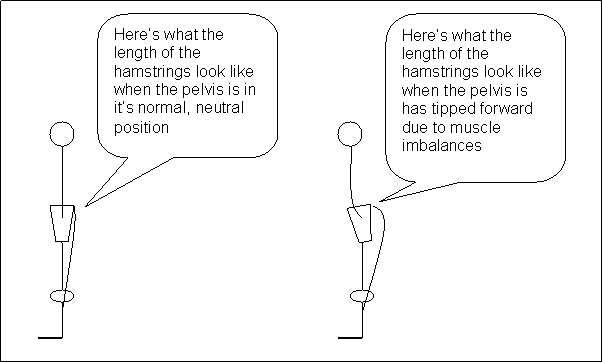Welcome to article number 3 in our series “Bodybuilding Sins That
Cause Back Pain and Missed Workouts”. In this article we are going to
talk about how bodybuilders tend to create massive muscle imbalances
and what you can do to not be one of them.
If you missed the first article, you can read it by clicking on
the link below.
Stretching can be great, but it can also make existing injuries
worse or even bring about new ones!
The key to making stretching work for you is knowing which
stretches you need to be working on… and just because a muscle feels
tight, that doesn’t necessarily mean it needs to be stretched.
For example, many people stretch the hamstrings because they feel
tight and they think the hamstrings are limiting their flexibility…
the fact is, most of the time the hamstrings are “tight” because
they are constantly being pulled / lengthened due to muscle imbalances
that tip the pelvis forward.
Below is a scary
attempt of artwork to show you visually what we are talking about:
As you can see, when the pelvis tips forward the hamstrings get
pulled upward and are constantly held in a stretched position…
And this is why millions of people can stretch their hamstrings
every freakin' day and never make any improvement in their flexibility….
Are you one of those people?
If you are, you need to stop stretching your hamstrings and find
out exactly which muscles you need to be targeting by reading the rest
of this article…
Not only does this forward tipping of the pelvis (which is caused
by muscle imbalances) keep the hamstrings tight and make it very
difficult to make improvements in the muscles flexibility, but it also
leads to the following:
• increased stress / wear and
tear from the ankles all the way up the spine
For example, the forward tipping of the pelvis places uneven
pressure on the ankle, knee and hip joints and also many of the
vertebrae in the spine.
• weakens the hamstrings,
inhibits normal functioning and increases the likelihood of hamstring
pulls
When the hamstrings are constantly being strained because of the
muscle imbalances, the muscle is weak, not able to function as it
normally would, prone to injury and without correcting the muscle
imbalance recover can take up to 9 months to a year, or longer!
• creates excess curvature in the
lower and middle spine
This tipping of the pelvis places excessive amounts of abnormal
stress on the muscles, vertebrae and discs in the lower and mid spine
and this sets you up for potential injuries to the muscles of the lower
and middle back…
Plus, it also causes the discs between your vertebrae to wear down
and deteriorate much faster than they normally would and this sets you
up for degenerative, bulging, protruding and herniated discs along with
numerous other spinal conditions like arthritis, spinal stenosis, and
the oh so popular sciatica!
<>
This hamstring example is just one of many… muscle imbalances are
responsible for nearly every ache, pain, injury and condition out there!
Here are a few more examples of injuries / conditions that are
caused by muscle imbalances and can easily be prevented and/or
eliminated with targeted stretches and exercises:
• upper back and neck pain
• shoulder injuries (rotator cuff)
• elbow and wrist pain (carpal tunnel, tennis/golfer/baseball
elbow, etc)
• knee pain (runners knee, chondromalacia, ligament tears, etc)
• hip pain (IT band syndrome, bursitis, etc)
• ankle pain (Achilles tendonitis, shin splints, plantar
fasciitis, heel spurs, etc)
All of these conditions are caused by muscle imbalances and will
NOT go away unless you work towards correcting the imbalances… and the
only way to know for sure which imbalances are causing your pain or
injury is to do a series of physical assessments like the ones covered
in our “
Lose the Back Pain
Video” which is designed for anyone suffering from back pain or
sciatica.
What the heck is a targeted stretch?
This is a question we are asked often and here’s the definition we
give it:
Targeted Stretch - a stretch or stretching exercise that is
chosen, based on physical assessments, to target a specific muscle or
muscle group to increase the flexibility and range of motion in that
area and bring the bones and or joints back towards the normal position.
When you compare a targeted stretch to general stretches like the ones
found in Yoga, Pilates and the corny ones your doctor, chiropractor or
physical therapist gives you, it’s no surprise they give little or no
pain relief and almost always fail to get rid of the problem.
Conclusion
Remember, the key to eliminating injuries and preventing future
ones is to identify what areas you need to target. In the next article
we’ll be discussing in detail, how to address various injuries like
back, hip, knee, and shoulder pain with targeted exercises. In the
meantime, be sure to read thru all of our detailed
Back Pain
Articles and if you have questions, please post them in our
Discussion
Forum.

